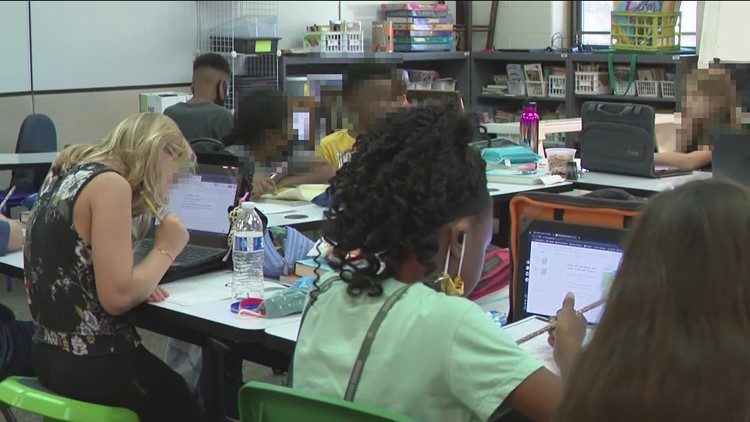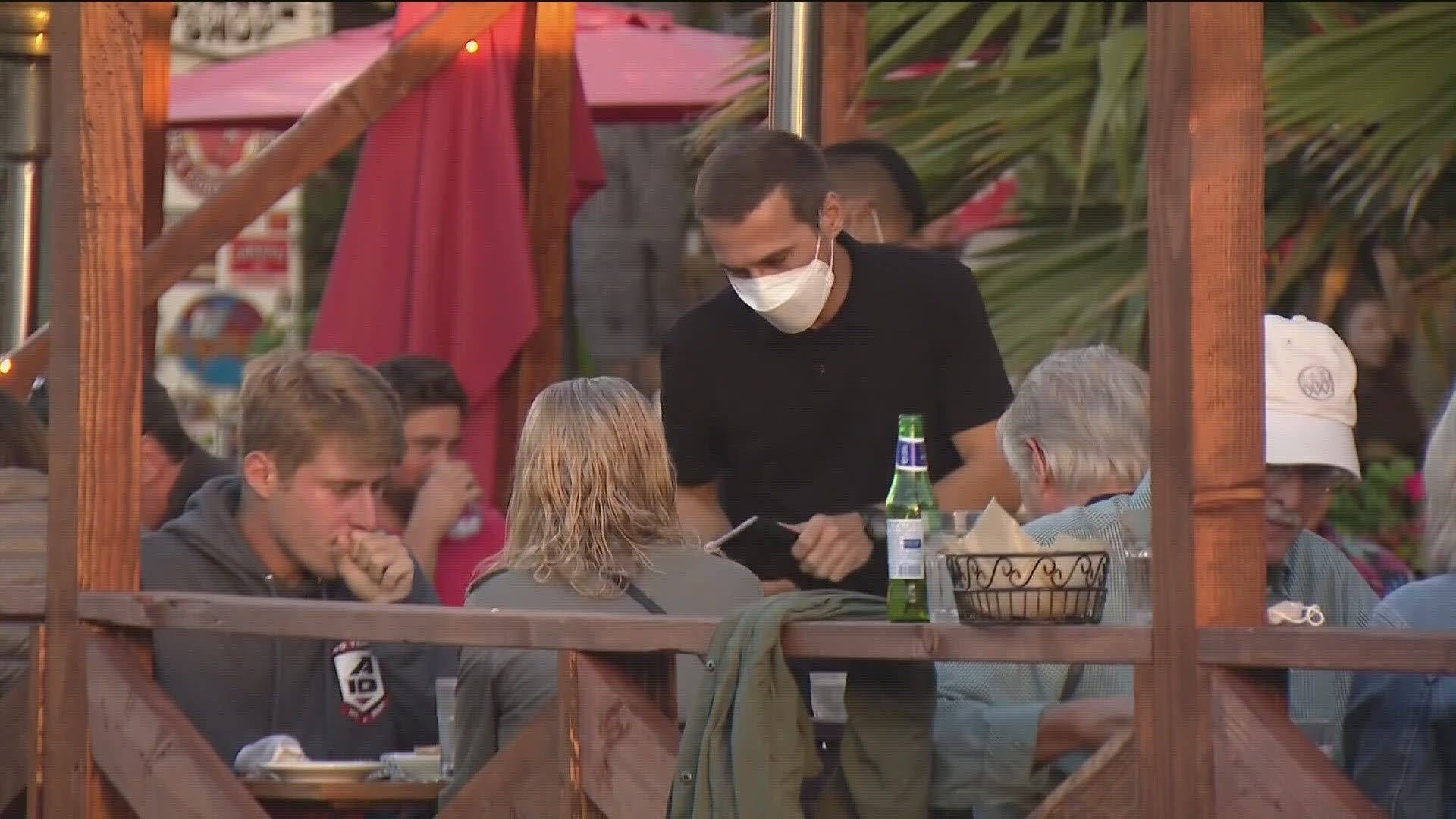CALIFORNIA, USA — COVID-19 hospitalizations among California’s children — especially those too young to go to school — are the highest they have been since the pandemic began.
Chalk it up to the highly contagious omicron variant, kids exposed during in-person instruction at school and other public places, and infants and preschoolers being ineligible for vaccination.
The state has tallied nearly 850,000 cases of COVID among kids 0 to 17 since the beginning of the pandemic. Of those, 44 have died — equivalent to an entire school bus filled with kids.
“The wave of delta and wave of omicron challenged some assumptions we had that kids would not get it and got spared,” said Dr. Theodore Ruel, chief of the Division of Pediatric Infectious Diseases and Global Health at UCSF. “Now we know that kids absolutely do get infections, and even though they are small numbers they do get admitted and some die.”
This peak in hospitalizations of kids across the state has surpassed records set during last winter’s surge, said California Health and Human Services Secretary Dr. Mark Ghaly last week. The state reached a high of 90 pediatric admissions in one day on Jan. 4, according to the California Department of Public Health. The previous high of 41 pediatric admissions in one day occurred in January 2021, a record surpassed earlier during the omicron surge on Dec. 29 with 50 admissions.
“The case numbers in children are skyrocketing along with those in adults,” Ruel said. “Children were spared infections early on and I think it was because of the shut down and school closures, and children had less of an opportunity to run into infected kids.”
California’s public health department is running a statewide marketing campaign and doing community outreach to raise awareness around vaccination. The campaign targets parents and is going out on social media platforms like Twitter and Snapchat. In an email the department said the community outreach is focused on the state’s more impacted communities.
Pediatric experts across the state say that so far families don’t need to go back to sheltering in place with children to avoid omicron or complications, including a rare multi-inflammatory syndrome known as MIS-C. They cite the need for schools and day care for working families as well as the social isolation that has made the pandemic tough for kids.
But they are advising families to revisit early pandemic precautions about limiting get-togethers, avoiding unnecessary activities and protecting their youngest and most vulnerable family members by masking, social distancing and getting vaccinated.
In Orange County, a child under 5 died from COVID complications in December, the county’s health agency said last week.
California mirrors the nation in seeing the highest number of pediatric hospitalizations with COVID-19 since the beginning of the pandemic, said Dr. Rochelle Walensky, director of the Centers for Disease Control and Prevention, in a briefing on Friday. Still, hospitalizations are relatively low with rates of 4 in 100,000 for those under 5 and 1 in 100,000 for kids five and above.
In Los Angeles, Dr. Colleen Kraft, a pediatrician at Children’s Hospital Los Angeles, worries about the number of sick kids because even a small percentage could mean thousands of ill children. Already this year, among symptomatic kids in the emergency department, 45% are testing positive, up from 2.9% in November, she said.
“Omicron is so contagious that the people that are unvaccinated are at highest risk,” Kraft said. “In many cases we have families and parents who could be vaccinated who are choosing not to and they are putting everyone at risk.”
At her hospital in the Hollywood area of Los Angeles, 41 children are currently admitted and a quarter of them are in the intensive care unit, she said. It’s the highest number of admissions in the last 12 months for the hospital.
She is most concerned about children who are not vaccinated, especially those under 5.
“Parents and family members that come in contact with them should be vaccinated,” Kraft said. “For the next few weeks while the cases are really high, they should think about whether they want to be doing their extra activities or things that are more optional.”
In California, 65% of children aged 12 to 17 are vaccinated, while just 19% of youngsters aged 5 to 11 are vaccinated, according to state data. Those figures are just slightly ahead of national averages of 54% and 16%, respectively.
For one family in Orange County, the consequences of the surging omicron variant came due just after the new year when their toddler was hospitalized with COVID-19.
Adeline Zermeno, 2, developed a fever around Christmas and tested negative for COVID. A little more than a week later she landed in the hospital after a 10-day stretch of non-stop fever that reached 104.9, fatigue and a positive COVID test, said her mom, Lindsey Zermeno.
Adeline spent two nights in the hospital with ear and sinus infections brought on by COVID and is still dealing with a lingering viral rash. Her big brother and father got sick too but their cases were mild.
The family had gathered with their extended family for Christmas and everyone who could be was vaccinated. Still, nine of the 23 attendees got sick, including Adeline.
“It felt incredibly scary,” said Lindsey Zermeno, a nurse at Children’s Hospital Orange County where her daughter was admitted. “There is so much that is unknown about COVID and although for the most part many people get through it just fine, there are still so many unknowns.”
Now she is vigilant for signs of MIS-C, a rare syndrome marked by inflammation in the body’s organ systems, including the heart, kidneys and brain.
“I pray to God that we get skipped over for that complication because it was so stressful having her in the hospital,” she said.
There have been 783 MIS-C cases in California during the pandemic.
“It is rare but it is very severe and kids have died from it, they can require life support, it causes decreased heart function,” said Dr. Angela Dangvu, a pediatrician at the Children’s Hospital of Orange County Primary Care Network who works at an off-site clinic. “It’s all a balance. Parents have to decide what kind of activities are important for their kids and the chance of them getting sick.”
In addition to the risk of MIS-C, children who have had COVID are also at risk of what has been dubbed “long COVID” and, separately, an increased risk for diabetes, according to a new study from the CDC.
For all these reasons, experts said vaccination among kids who can get it is critical. If they get a breakthrough case, their symptoms are typically mild and the vaccine helps prevent longer term complications, said Dangvu, who is Adeline’s pediatrician.
Doctors said drug-makers are conducting pediatric vaccine trials for those under 5 and recently changed the testing plan to include a third dose for those 6 months through 4 years old to see if that boosts their immunity to COVID.
As for Lindsey Zermeno, she can’t wait for the vaccine to be available for her daughter.
“I’m very anxious for the vaccine,” she said. “As a former pediatric ICU nurse, I’ve seen really bad things happen to kids because they were not vaccinated for the flu or pertussis.”
WATCH RELATED: CDC reports record number of kids hospitalized with COVID



